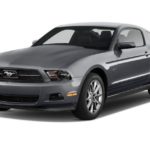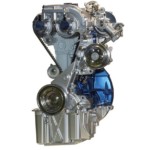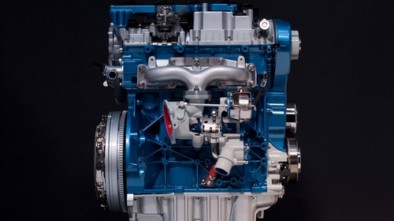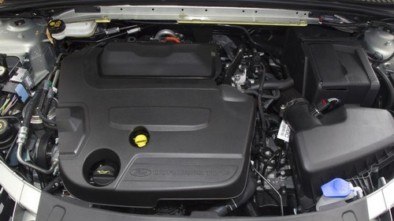Ford Mustang - part one - model history
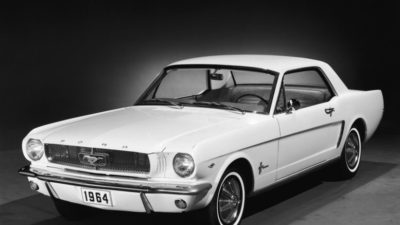
Ford Mustang
To be able to understand how the Ford Mustang became part of American culture, it is necessary to explain how Ford came up with the idea to produce this icon of the American and world car industry. After a fairly peaceful 1950s, the situation changed abruptly during the early 1960s. President John F. Kennedy was assassinated, blacks began to demand their rights, the war in Vietnam began to create problems as did the Cold War with the Soviet Union and the problems with Cuba. But in the world of the auto industry, the situation has never been better. Many believe it is Chevrolet Corvair the reason for being Ford Mustang. The Corvair had an engine at the back, a 150hp turbo engine, and began to attract customers who used to buy mostly imports in the past. Others say the so-called baby boomers (a nickname for people born during and after World War II) were graduating from college during this period and wanted a sports car that would also be practical and inexpensive, and there are those who say that Ford wanted a sportier and cheaper version of the Thunderbird model. The answer is probably somewhere between the three stories listed, and while believing the Mustang was the right car at the right time, the situation was not so simple. Namely, Ford In 1958 he introduced the new Edsel Division with the aim of attacking Chrysler and Oldsmobile. However, just three years later, the Edsel was shut down and cost Ford $ 200 million back then. The big loss on the Edsel forced Ford to look more closely at the investment, and this had a big impact on the Mustang.
If you had to choose one person as the father of the Mustangs it would certainly be Lee Iacocca. The son of an Italian immigrant, Iacocca became famous by promoting 56 for 56 ($ 56 a month for 1956 Ford) and by November 1960 became Ford Vice President on his 36th birthday. That same year, Iacocca wanted a new sports car and had a large group of people around to help. Among them were Don Frey, who planned the entire production, his assistant Hal Sperlich, then Jacques Passino, who would later bring Carroll Shelby to Ford, and Don Petersen, who was marketing and eventually Bob Eggert, who did an investigation into what cars people want. The main designer was Gene Bordinat, with Joe Oros, Dave Ash, Charles Phaneuf and young Phil Clark still working on the team. Rumor is that Clark tried to sell the idea of General Motors' Mustang that he wasn't interested in, so he ended up at Ford. In the same period, Ford's junior car was a Falcon, a small economy compact that became the best-selling car in America overnight when it was introduced in 1960. Iacocca made sure the Falcon also got a sports version called the Futura and had a V8 engine, leather seats and a manual transmission, but it failed to attract younger customers to the extent Ford had hoped.
One prototype was made, known as the Mustang I, but it was a roadster with a V4 engine and minimal chance of production. By early 1962, Iacocca had a detailed plan for a new sports compact, but Henry Ford II, then president Ford, persistently rejected this idea. Henry II feared another catastrophe like Edsel, but he also cared how much that new car would take from selling the Falcon. In addition, Henry II had already earmarked as much as $ 250 million for the new design of the complete Ford line for 1965, and there was no room for another model. After the seventh launch, Henry II approved the model, but announced to Iacocci and Frey that they would not like his decision unless the car was a success. Iacocca also received a budget of just $ 40 million and just 18 months to finish the job. Iacocca wanted a car that would share the platform and most of the parts with the Falcon, but with a long selection of standard and optional equipment, weighing 1125 kg and a starting price of under $ 2500. The idea was also to share a Mustang (developed under the name Cougar) two Falcon engines, a 2.8 L I6 with 101 hp and a 4.3 L V8 with 163 hp. By October 1963, the second prototype, known as the Mustang II, was finished and started testing, and Ford introduced this prototype to the audience as a concept for a future sports model. Although the prototype was well received by the audience, CN Rueter, one of Ford's chief engineers, thought it would be a failure and that Ford threw huge sums of money at a car that no one would want to buy.
Ford Mustang 1964 - 1966
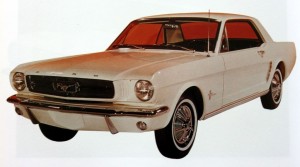
The Ford Mustang was unveiled to the public on April 17, 1964 at the New York World Fair. The first models were known as the 1964 ½, and Ford deliberately chose the spring to introduce the new cars to get the most media attention possible. At least one Mustang was in each of Ford's 8,100+ dealers, and in addition to a large number of TV, radio and newspaper ads, Ford also invited editors of well-known car magazines for testing. A few days before the official presentation, Ford also showed the audience the quality of the Mustang when they transported seven cars from New York City to Ford's headquarters in Dearborn, Michigan without any problems. But probably Iacocca himself did not expect the popularity that the Mustang gained. Research has shown that the Mustang was seen by as many as 29 million people on TV plus another four million at Ford dealers, and the next day the Mustang appeared on the front pages of all newspapers. The starting price of the Mustang was only $ 2368, and from a seat inside for four adults, many said that the Mustang was like a Model A sports car. On the first day alone, 22000 units were ordered, and Ford quickly realized that there were many more customers than cars. The Ford Mustang quickly found its place on TV screens when it appeared in the famous James Bond film Goldfinger. Rumor says that Ford was preparing a golden Mustang that was not ready in time, so a white Mustang convertible was used in the film.
Ford had hoped for an annual sales of 100000 units, but by the end of 1964 over 120 Ford Mustangs had already been sold. In the first 000 months, Ford sold as many as 12 Mustangs on the market, which still holds that record, and as many as 419% of customers opt for the V000. The choice of standard and optional equipment was so long that it is impossible to find two identical classic models today. The Mustang was also a pace car on the 73 Indy 8, and under the hood was a new 1964L engine with 500 hp that was not yet available to the public. A 4.7 fastback was also on sale, but the coupe was still the best-selling, accounting for 271% of Mustang's total sales. However, despite all the praise, the Mustang couldn't boast some performance. The strongest engine, however, was only 1965 hp, and could not be found alongside cars such as the Pontiac GTO, Chevrolet Impala and Ford Galaxie. Iacocca quickly got to work and called his great friend Carroll Shelby for help. Iacocca and Shelby had worked together a few years earlier when Shelby had partnered with Ford for Shelby Cobra, and they were both working on a new sports car, the GT75. In order for the car to qualify for the then Sports Car Club of America (SCCA) at least 271 serials had to be made. Shelby easily made that number, with a 40hp V500 engine under the hood, and drivers Jerry Titus, Bob Johnson and Mark Donohue completely dominated the tracks. Sales of these special models, called the GT306, did not go as expected, and a few months later, much of the car was sold to Hertz, who rented them. After only 8 months in the market, Ford sold the millionth Mustang, and sales for 350 totaled a staggering 18 units. However, as muscle cars became increasingly popular overnight, Ford thought it was time for a change and for a better-performing new Mustang.
Ford Mustang 1967 - 1968
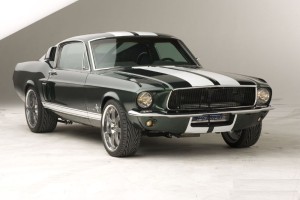
By 1967, the Mustang got something it didn't have before, which is competition. General Motors finally realized that Chevrolet Corvair couldn't do the job, and in 1967, it prepared two twins as competitors, Chevrolet Camaro i Pontiac Firebird. Plymouth also introduced the new generation of Barracuda, AMC entered the market with Javelin, and even Mercury introduced the new Cougar. The Camaro and Firebird also had big block engines (the Camaro 6.5 L and the Firebird 6.6 L), while the largest engine in the Mustang was still only 4.7 L. Then Hal Sperlich entered the scene, who did not want the Mustang to get dimensions like a Ford Thunderbird , but he knew he had to make changes to keep the Mustang on top. To open up space for a larger engine, the Mustang had to get dimensions, but the difference was not drastic. The design retained similar lines to the previous ones, but with a more aggressive front end and big enough changes for the customer to notice the new model. Although today many consider this Mustang to be the most beautiful, Iacocca was not happy with the work done. In his autobiography, Iacocca wrote that in 1967 the Mustang became a fat pig from a beautiful horse. The biggest news, in addition to the design, was the introduction of the first big block engine. It was a 6.4L Thunderbird Special developing 320 hp and replacing the 4.7 L High Output. The 4.7 L still existed, now with 200 hp and 225 hp, and for customers who wanted economical Ford offered two I6 engines (3.3 L with 120 hp and 4.1 L with 155 hp). Collaboration with Shelby continued, and for the first time the Mustang Shelby differed in design from the regular Mustang in its new hood and taillights. Next to Shelby GT350 which still used a 4.7 L engine, the customer could now also get a Shelby GT500 with a 7.0L engine and 335 hp, which was also Ford’s racing engine for NASCAR. Although the competition attracted new customers, Ford sold 1967 Mustangs in 472000, which was still by far the highest in its class. For 1968 the identical 7.0 L, which the previous year could only be found under the hood of the Shelby GT500, has now become an option on all Mustangs. However, the big rival Camaro could be obtained with a 375 hp engine, so Ford called its well-known dealer, Tasca, for help. Tasca has become famous in the past by making special racing versions of the Mustng, and the results on the tracks have not been lacking. That didn’t go unnoticed by Ford who invited Tasca to visit Ford’s factory in Dearborn, Michigan and suggest what could be done to get the Camaro off the top. Tasca proposed a new racing engine, known as the 7.0 L Cobra Jet, which developed 335 hp on paper, but in reality over 400 hp. Henry II approved and in mid-1968 this engine was offered. Ford has also noticed that many people do not buy a Mustang because of its performance but because of its image. That is why, for 1968, it offered several different special versions, the most famous of which is the California Special, and High Country, Lone Star and Stallion should also be singled out. One of the most famous 1968 Mustangs is the green fastback with a 6.4 L engine that Steve McQueen drove in the popular movie Bullitt. The San Francisco chase between the aforementioned Mustang and Dodge Charger is today considered the best chase ever seen in the film. Interestingly, Ford on two occasions, in 2001 and 2008, offered the Bullitt as a special version of the Mustang in honor of the car from the film.
Ford Mustang 1969 - 1970
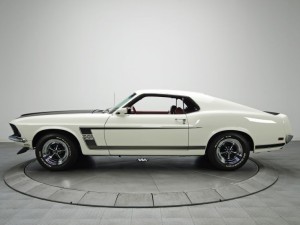
Until 1969. the once great Mustang began to show the first signs of weakness. Due to high competition, sales dropped below 300000 units for the first time, and the company also had a quarrel over how the next Mustang should be done. Semon Knudsen, better known as Bunkie, was brought in from Pontiac after much success with larger models. Bunkie believed that the Mustang should be bigger and more luxurious in order to attract other buyers besides the younger ones. The 1969 Mustang was larger than its predecessor and had a new design, but still kept the lines from the original model. The buyer still got the choice of two I6 engines and as many as eight V8 engines, which accounted for 80% of Mustang sales. The customer could choose between 5.0 L with 220 hp, 5.7 L with 250 hp and 290 hp while at the top of the offer were still 6.4 L with 320 hp and 7.0 L with 335 hp and 360 hp. The customer also continues to get the coupe, convertible and fastback, and the big news was the introduction of the luxury Grande version. Another big news was the introduction of the sporty Mach 1 version that could come with any V8 engine, and for many, the 1969 Mach 1 with a 7.0 L engine and Shaker hood is the best Mustang ever made. Bunkie also believed that track scores were high in sales, and at all costs, he wanted the Mustang to dominate the Trans Am Series back then and win the 1968 title again. taken over by the Camaro. Ford also took control of Shelby models in 1969. unveiled the all-new Shelby GT350 and GT500, which for the first time did not share the design with the rest of the Mustang lineup. Bunkie was unhappy with the job Shelby was doing and wanted a powerful Mustang by Ford, not by a tuner. As a result, two special versions were created, the Boss 302 and the Boss 429. The Boss 302 was intended for the Trans Am series at the time, with a 5.0L 290hp engine under the hood. The Boss 429 was built to meet NASCAR standards (although the Mustang never competed in the strongest NASCAR series), and as its name implies under the hood was a huge 7.0L engine with 375 hp on paper (in reality over 500 hp). In addition to the engines, both models had specially modified suspension and larger brakes, and Larry Shinoda, brought in by Bunkie from General Motors, took care of the development. Both models have had a lot of success. The Boss 302 won the 1970 Trans Am Series title with driver Parnelli Jones while the Ford Torino with 7.0 L engines from the Boss 429 won in 1969. title in NASCAR with driver David Pearson. The 1970 Mustang was almost identical to the 1969 Mustang, with the exception that the twin headlights were gone. By 1970, Mustang sales had dropped to just 191000, and Ford realized it had to go the other way. Bunkie was fired by Henry II and replaced by Iacocca, who wanted a brand new Mustang for 1974. It has also become clear that the muscle car era is over and fuel will never be cheap again, and insurance companies have begun to raise the prices of their services. In addition, the state has set standards for the first time on exhaust and safety measures.
Ford Mustang 1971 - 1973
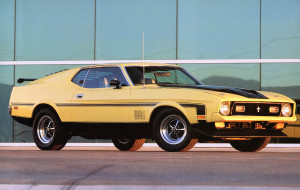
The largest and heaviest Mustang ever made saw the light of day in 1971, and Bunkie was responsible for its development, which was also his last work before he left Ford. Bunkie wanted the Mustang bigger so that rear seat passengers would have more space, but also to open up space for larger engines. Such ideas brought Bunkie fame to Pontiac, but at Ford (Mustang and Thunderbird) only criticism followed. The 1971 Mustang was about 270 kg heavier than the original 1964 Mustang and from a small sports car it became a large and heavy muscle car. Rumor also says that Bunkie approved the new design after just one look and was not interested in other designer ideas. During its three years of production, the Mustang has remained largely the same in design, with the exception of small items such as bumpers. The Falcon platform was again modified to withstand more weight, but comfort was certainly a big improvement. For those who wanted a sports model there was still a Mach 1, now with a standard 5.0 L engine and 210 hp, and for performance fans the Mustang could now be obtained with a huge 7.0 L Cobra Jet with 370 hp. The Mustang regained fame on the small screens after Sean Connery rode a red 1971 Mach 1 in the James Bond film Diamonds Are Forever. The collaboration with Shelby is over, and after exiting Trans Am and NASCAR Ford saw no reason to re-produce the Boss 302 and Boss 429 (although the prototype image says Ford planned the 1971 Boss 302). As a last farewell, Ford offered the Boss 1971 in 351. As its name suggests, the Boss had a 5.7 L engine with 330 hp as well as a modified suspension and brakes, and many say that this is the last original Mustang worthy of attention. By the end of 1973, power had largely continued to decline due to new exhaust standards, and the most powerful and largest engine, the 5.7 L, had only 266 hp. The only model worth noting was the 1972 Sprint, which, along with the Pinto and Maverick models, came only in white with the American flag and was made part of the American Olympic team. Fortunately, Iacoccin's little gem was ready for series production.
Ford Mustang 1974 - 1978
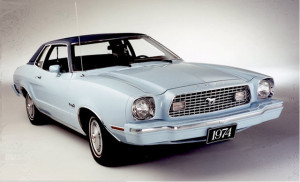
If someone asks you which is the best Ford Mustang ever made real car connoisseurs would probably say 1969 Boss 429. Others would still say some of the Shelby models, and there are those who would opt for the Mach 1. However, probably no one will mention the Mustang II which was produced from 1974 to 1978. Many will say that this car does not deserve to bear the Mustang name, but if you look at the details, the Mustang II may have been the most important Mustang in the 44-year history of this car. Probably not as fast as today's Shelby GT500KR with 590 hp or as beautiful as the original 1965 GT Convertible, but the Mustang II still saved the Mustang from ending up the same fate as most muscle cars from that period. By the early 1970s, the Mustang had grown into a huge car, and during the oil crisis, customers were turning to economical cars. There are several reasons for the death of muscle cars. The US government decided for the first time to introduce safety measures and exhaust gases in cars, and insurance companies made the situation worse when they increased the prices of their services for all those who had sports cars. America became very nervous in 1973 when OPEC decided to stop selling fuel to America after they supported Israel in the war against Syria and Egypt. Suddenly, no one wanted a muscle car anymore, and Ford Pinto, Chevrolet Vega and AMC Gremlin began to dominate the streets. Even General Motors was thinking of shutting down the Chevrolet Camaro and Pontiac Firebird. By that time the Mustang had become large, heavy and expensive. Then came Lido Lee Iacocca who made a car that, loved or hated, still retained the legendary Mustang name and was the right car at the right time. Iacozza was the man behind the original 1964 Mustang and wanted the new 1974 Mustang to be made with the same idea, and that refers to its smaller dimensions, economy and cheap price. Iacocca had two ideas for the Mustang, one on the Ohio platform on which the very popular Ford Maverick was presented three years earlier, and the other on the Arizona platform on which the little Pinto was made. Great success of vehicles such as Datsun 240Z, Toyota Celica, Opel GT like Ford's Capri made Ford opt for the Arizona platform after all. The Mustang was smaller in size than the Maverick, and since the Maverick had a V8 engine, it was decided that the smaller Mustang would only be offered with I4 and V6 engines. For the first time in history, the Mustang was supposed to be available with the I4 option and no V8 option. As the 1.6L and 2.0L Pinto was a huge success Ford decided to build a brand new Mustang-only I4 engine, the size of the 2.3L, which was also the first new I4 engine from Ford in America since 1934 and a Model B. The 100hp engine was as economical but as fast as the previous generation I6. The 6-liter German Ford engine, which developed 2.8 hp, was taken as a V119 option. For the design of Iacocca he sought help from the famous Italian company Ghia, who tried to make a design similar to the 1964 Mustang. The weight of the vehicle was reduced by about 450 kg and the Mustang II went on sale in late 1973 as a 1974 model. Motor Trend Magazine was quick and declared the Mustang the 1974 Car of the Year, with sales going great and over 386000 copies sold in the first year. Ford decided to leave the famous Mach 1 name for the Mustang II even though the model was just a shadow of the Mach 1 from the past, and there was a Ghia version that replaced the Grande. The Mach 1 only came with the fastback, while the Ghia only came as a coupe. Both models came with I4 and V6 engines as options. The Mach 1 was aimed at those who want a sporty image while Ghia provided the luxury of European cars. As OPEC began re-importing fuel into America the following year, customers wanted the V8 Ford offered in 1975. It was a 5.0L engine that developed 122 horsepower to later increase power to 139 hp. Unhappy with the image that the Mustang II lacks power Ford decides that in that case the car at least has to look fast. For 1976, Ford introduces a Cobra II version of a Mustang done by a Can Am company. The easiest way to identify the Cobra II is by the large Cobra straps on the vehicle door as well as the front bumper spoiler. In the first year, Ford sold 25259 Cobra IIs, and the big reason for the popularity lies in the fact that actress Farrah Fawcett was driving a Cobra II in the popular Charlie's Angels series. For the last 1978, the Mustang II Ford decided to offer a special King Cobra version to fans of this car. During this period, the black Pontiac Trans Am with gold bars came into focus after the great success of the movie Smokey and the Bandit, so Ford decided to offer the same measures to the Mustang King Cobra. Only available in the fastback version of the King Cobra had the Cobra Gold logo on the hood, special front bumper, gold King Cobra tags and rims, a 5.0 L engine and came with full equipment. This equipment package was $ 1277 leading to a total price of over $ 6000, and that is probably why only 4971 units were sold. The Mustang II was officially shut down when Lee Iacocca was fired at Ford, and new President Philip Caldwell decided to come up with a different idea for the 1979 Mustang. Today, the Mustang II is in a really bad reputation and with the exception of the King Cobra and the good preserved Cobra II, no model holds up for price. There are several reasons. Most resentment concerns the Pinto platform with which the Mustang II only shared some parts. However, it should be mentioned that the original Mustang was based on the Falcon compact as well as the 1979 Mustang on the Fairmont compact. Still others will look for reason in a weak engine, but it should be said that the Mustang II offered solid performance for its price. True, the 1978 Mustang 5.0L only had 139bhp, but the Chevrolet Camaro only had 6bhp from the slightly larger 5.1L engine. Even the 5.7 L four-car version had only 185bhp, and at $ 6500, the Camaro was as much as $ 2500 more expensive than the Mustang, which is why Chevrolet probably dropped this version after 1975. The 1981 Mustang had only 118 hp from a 4.2 L engine, and the 1983 Mustang GT 5.0 L, considered by many to have awakened the whole muscle car spirit again, had 157 hp or just 18 hp more than the Mustang II 5.0 L. The fact is that the Mustang II was a solid performance in its time, and with over a million copies sold in five years it definitely deserves a name in history.
Author: Talladega
Retrieved from: www.brzabrzina.com
Recommendation of similar texts:

Hi there, I am Mladen and I am an auto enthusiast. I started this blog years ago to help like minded people share information about latest cars, car servicing ideas, used car info, exotic cars, and auto technology. You will find helpful articles and videos on a wide variety of cars - Audi, Mercedes, Toyota, Porsche, Volvo, BMW and much more. Ping us if you have anything cool to share on latest cars or on how to make older cars more efficient, or just want to say hi!

